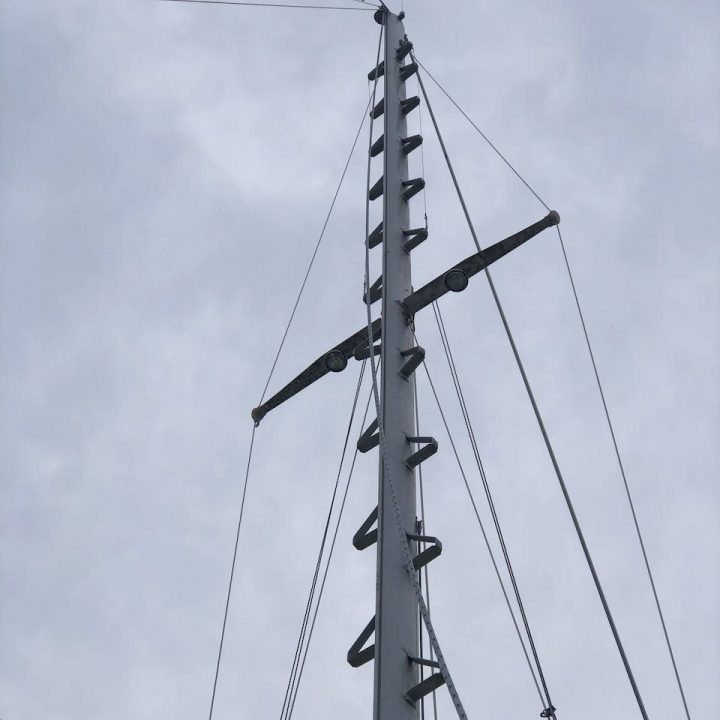One of the inevitable parts of owning a sailboat is climbing the mast. Some people enjoy this task. For them, it’s another part of the adventure. But I am not one of those people.
For me, there is only one task that is worse than going up the mast. I will spare you the gory details, but it may surprise you to learn that it does not involve the toilet. That’s right, climbing the mast is worse for me than dealing with toilet issues.
Mast climbing is made even worse due to my trust issues. While I usually have two or more people around to winch me up, I don’t trust any of them. Not my wife, not the weirdo from the next dock, and not the “professionals” I know who would be willing to help.
So I set out to learn how to do it myself. I am by no means an expert, but I have successfully climbed up and back many times now on several boats. I can do it myself if needed, but I still like having a helper around to hear my screams and fetch me tools.
Table of Contents
- How to Climb a Mast with Two People
- How to Climb a Mast Solo
- Mast Climber Sailboat Options for Every Boat
- Mast Ladder and Mast Climbing FAQs
How to Climb a Mast with Two People
Before diving into how a solo sailor might climb up the rig, let’s look at how most people tackle the problem. The traditional sailor’s solution is the lowly bosun’s chair.
The bosun’s chair is simply a board attached to wide nylon webbing that you can sit on. The webbing is attached to a halyard, and the halyard is winched up the mast by someone on deck.
Prices pulled from the Amazon Product Advertising API on:
Product prices and availability are accurate as of the date/time indicated and are subject to change. Any price and availability information displayed on [relevant Amazon Site(s), as applicable] at the time of purchase will apply to the purchase of this product.
Bosun’s chairs vary in features. Some are as simple as a board with straps. Others are much more secure and comfortable, with a back to keep your bum in place and straps around your thighs to ensure it does not slip. Of course, the more secure and comfortable it is, the easier it is to do projects with two hands. Many sailors like to use a climbing safety harness
It takes quite a lot of winching for the deckhand to get you to the top. It’s the only job on my sailboat that makes me wish for an electric winch, actually.
Safety First
Going up the mast is all about planning and playing the “what if” game. For safety, please make sure everyone involved knows their roles. It’s advisable to put someone on the winch who is well-versed in cleat hitches, clutches, self-tailing or non-self-tailing, and whatever else you’ve got going on. Shouting about which line to secure where and how is the last thing you want to do as you swing 50 feet off the deck.
Always have a safety line. Yes, it increases your work and gives you one more thing to worry about. But it just might save your bacon.
Don’t forget to plan out precisely what you’re going to be doing once you get where you’re going. Walk through every action you need to take.
Make sure you take all of the tools you need—and might need—with you. I like to take as much as I can in a close-fitting messenger or sling bag. The only thing worse than mast climbing is doing it multiple times. Of course, you can have your helper send tools and parts up and down with a bucket, but it adds complexity to the operation and lots of potential to be aggravated.
How to Climb a Mast Solo
All of this is well and good if you have a helper, but what if there is no one around? Solo mast climbing requires even more planning out and thinking. The same rules apply, but now you’ve got to figure out how to get to the top without anyone else’s help.
A safety line is essential even with these options, so plan accordingly.
The top ways for a solo sailboat mast climber to accomplish the task are listed below.
- Block and tackle self-climbers
- Climbing ascenders, like the ATN Mast Climber
- Fixed mast steps
- Hoistable sailboat mast ladders
Self-Climbing Gear — Block and Tackle Climbers
Professional riggers have been going up masts by themselves for a long time, so it’s no wonder that they’d have some pretty good systems worked out. While some depend on a ground-side helper to winch them up, many prefer the freedom of using a custom-made block and tackle setup.
If you want to go this route, you’ll want to be very good with rope handling and marlinspike seamanship. You’ll also need to invest in some nice hardware. Most sailing stuff comes marked “not for human climbing.”
Most of these setups attach to the boat’s halyard. You then hoist one end of the setup to the top of the mast, and the other end is attached to your bosun’s chair at deck level. The bitter end is with the chair, and it includes a jammer or stopper. There’s enough purchase in the system to make hoisting yourself up a relatively simple maneuver.
These systems can’t get you right up to the top of the mast, but this is a weak point for most climbers.
ATN Mast Climber
A slightly slicker version of the same idea is the ATN Mast Climber. This gadget is pulled right from the rock climbing world. Out of the box, you need no other rigging or parts to make it work.
Instead of hoisting anything up, the Mast Climber attaches onto an existing static line. Tie a halyard to the deck, and winch a bit to get the line taut. The Mast Climber then attaches to that line for the climb up. It’s easiest if the line isn’t perfectly vertical. I like to attach mine to the coachroof handrails. Being able to attach it anywhere on deck means you can position yourself to best reach whatever you need to work on.
The Mast Climber has two parts: the bosun’s chair climbing harness and the foot straps. Each attaches to your mast line with the climbing equivalent of a rope clutch. With a squeeze, they let you move freely up the rope. But once you release your grip, your weight jams them locked onto the line.
It takes a little practice to use the Mast Climber, but once you get the hang of it, you’ll be going up in no time. To my surprise, coming down is actually a little more challenging because it requires different timing and spacing than going up does. One tip–always wear sturdy shoes and gloves.
Mast Steps
The no-brainer solution for salty bluewater solo sailors is to install mast steps. These fixed metal steps attach to each side of the mast and allow you to climb up just like a regular ladder.
The steps are small, and you’ll need a safety line as well. But they do enable you to climb up the mast any time without having to get more equipment or worry too much about it. And short of falling off, they’re better fool-proof and easy to use.
Unfortunately, they are always there – and not exactly pretty. It’s a lot of hardware on your mast, which increases weight and windage aloft. From the installation side, putting them on is a big and expensive project that requires drilling many holes in your beautiful aluminum spar.
You might opt to install only a few steps to help you with other climbing systems. For example, many sailors install a pair or two at the masthead. Then when they arrive with their bosun’s chair or a self-climber, they have something solid to stand on. If the steps are positioned high enough, they’ll even enable you to work on the masthead.

Hoistable Sailboat Mast Ladder
A mast ladder is a hoistable ladder made of webbing. It goes up on the mast on your halyard and attaches into the mast track just like your mainsail—with slides.
Recovery Marine
- 50 Foot Mast Ladder
- Steps Double Reinforced
- Easy to Use Mast Ladder
- Man Overboard Ladder
Prices pulled from the Amazon Product Advertising API on:
Product prices and availability are accurate as of the date/time indicated and are subject to change. Any price and availability information displayed on [relevant Amazon Site(s), as applicable] at the time of purchase will apply to the purchase of this product.
Kinleven Marine Mast Ladder
This is probably the nicest hoistable mast ladder on the market. It’s made-to-order for your vessel, so you’ll have to supply a few measurements from your boat to get it built just right.
The best feature is the ladder’s rungs, which are made from sturdy and strong plastic. This gives the ladder the most solid feel of any available options. It’s like climbing a conventional ladder, more or less.
It’s also extremely stable because it is mounted on slides that match your mast track. Unfortunately, you will have to remove your mainsail to load it into the track. That’s a pain but shouldn’t take more than a few minutes.
Mast Mate
One of the best mast ladder sailboat owners can choose, the Mast Mate is simple and easy. Where the Kinleyen is a beautiful unit, it is custom made to fit your boat. Some sailors might favor a unit they can use on any boat, and the Mast Mate is just what the ship’s doctor ordered.
The disadvantage of webbing ladders like the Mast Mate is that the steps are made of webbing, too. That can make it hard to get a good foothold, and it’s far from comfortable. However, it does mean that the ladder folds up into a small and light package for storage.
Like the Kinleven, the Mast Made uses mast slides to keep the ladder in place. You might have to sew your own on if the maker doesn’t supply them.
Mast Climber Sailboat Options for Every Boat
Unless your boat has a mast small enough to put up and down quickly, the day will come when you need to climb it. It’s best to practice and have the gear onboard. That way, you can tackle the task and get back to sailing.
Mast Ladder and Mast Climbing FAQs
What is a mast ladder?
A mast ladder is one method to climb the mast of a sailboat for maintenance. Sailors often need to climb the mast to inspect the rigging, replace light bulbs, service wind instruments, or free tangled lines.
Mast ladders are made of webbing and collapse for easy storage. When you want to use it, remove your mainsail from the mast track, and insert the slides from the ladder. Hoist the ladder with your main halyard, securing the bottom and tightening the line. Use a second halyard as a safety line if you lose your footing.




